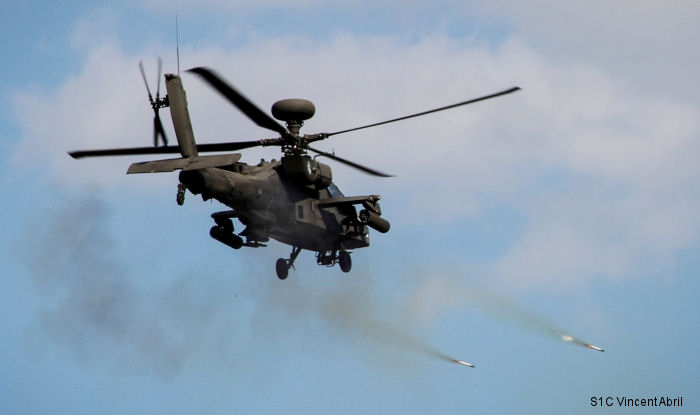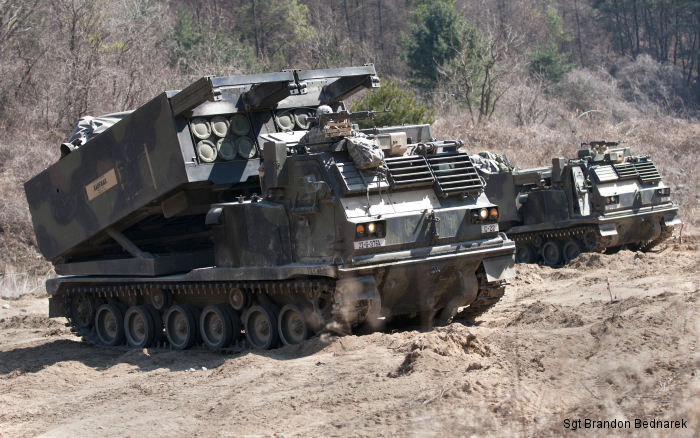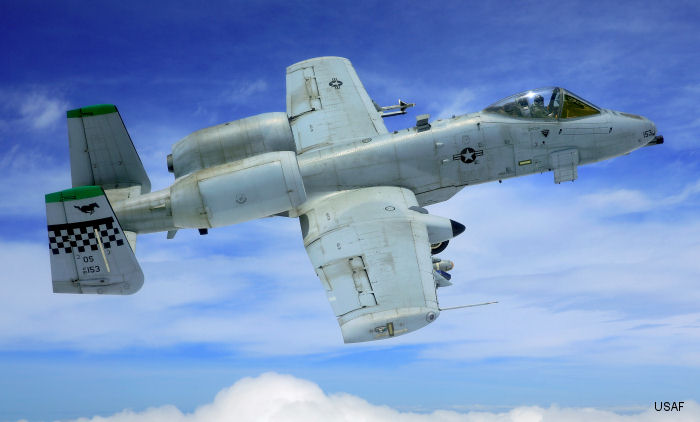US Army, April 07, 2015 - CAMP CASEY, South Korea by Sgt Brandon Bednarek - Utilizing momentum from the peninsula-wide Key Resolve exercise earlier this month, the 210th Field Artillery Brigade, 2nd Infantry Division, conducted a complex combined joint live-fire exercise March 25-26 just north of the unit's Camp Casey headquarters near Cheorwon, South Korea.
The training area, appropriately referred to as "Rocket Valley", was site of the brigade's tactical command center as well as logistical and support elements from the unit's 70th Brigade Support Battalion and fires capability from 6th Battalion, 37th Field Artillery Regiment.
Making use of a previous training scenario, the brigade executed their mission essential task of integrating fires in conjunction with a continuum of assets from the U.S. Air Force and Marine Corps and the Republic of Korea Army and Air Force.
"Something the Army says we have to be experts at is integrating fires," said Maj. Jeremy F. Linney, the brigade's operations officer. "One of the things we learned coming out of the Key Resolve exercise is a need for this brigade to be able to support multiple units on the battlefield - not just U.S. Army, but our ROK partners as well as our joint partners."
CROSS-BOUNDARY
To maximize employment of their integration capabilities, the exercise was divided into two major operations, beginning with cross-boundary fires from the brigade's Multiple Launch Rocket Systems and targeting from the Marine Corps' 5th Air Naval Gunfire Liaison Company.
The initial phase was intended to demonstrate the unit's ability to effectively use long-range artillery fire to establish freedom of maneuver for ground components of a joint service - in this case, the III Marine Expeditionary Force.
"One of the ways we offer flexibility and responsiveness to the senior maneuver commander is our ability to integrate and employ fires anywhere on the battlefield," said Linney.
In order to accurately deliver those artillery munitions on enemy targets, however, the brigade relied on the forward observers and target location expertise from the 5th ANGLICO, which is operationally controlled by III MEF.
"We are the liaison element that's able to interconnect fires between the Marine Corps MEF and the Army," said Maj. Carin Calvin, operations officer for 5th ANGLICO.
"We bring the surface-delivered fires capability as forward observers," said Calvin. "What we were able to do in this exercise was bring [targeting information] back to our command post and digitally send it to the Army so they can fire in support of us."
For this particular cross-boundary scenario, ground forces from III MEF needed assistance eliminating a hostile target outside the firing range of their own artillery assets. Without readily available air support to call on, the Marines looked to the brigade's superior long-range MLRS capabilities for target engagement.
"Interoperability is critical in anything we do," said Linney. "When we add our joint partners from the Marine Corps it becomes even more critical."
"The ability to employ fires, at the right place and right time on the battlefield, is a powerful response that the maneuver commander can ask of us," he said.
Acquiring the dexterity to produce successful attacks during a cross-boundary fire is an ability that can only be attained through methodical planning, tedious preparation and in-depth rehearsing, said Col. Michael J. Lawson, commander of the 210th Field Artillery Brigade.
When command emphasis is not sufficiently given to those critical requirements, field artillery units lose the ability to provide critical fires in combat, said Lawson.
JAAT
The second and final phase of the combined joint exercise culminated with the execution of a deep Joint Air Attack Team operation using artillery, fixed-wing aircraft and rotary-wing assets.
The complex aerial and land-based tactic is primarily used in combat to simultaneously attack an enemy's air defense systems, reconnaissance elements, and command and control structures to disrupt and delay movement, said Linney.
Situated from their firing positions at Rocket Valley, MLRS units from both U.S. and ROK artillery commenced the multi-pronged attack by launching of rockets to suppress simulated air defense targets near an impact area more than seven miles away.
With enemy air defense suppressed, A-10 Thunderbolt II aircraft from the U.S. Air Force's 25th Fighter Squadron conducted a flyover of targets at Rodriguez Live Fire Complex while three Apache attack helicopters from 2nd Combat Aviation Brigade, 2nd ID, dissolved any remaining targets in near rapid succession with Hellfire rockets and 30mm chain guns.
For safety and risk mitigation purposes, the JAAT components were executed in two training locations, with artillery and air elements protected by horizontal separation and fixed and rotary-wing elements protect by altitude separation, said Linney.
The execution of a JAAT, whether combined or joint, is unmistakably reliant on aviation operations from friendly units in a shared battle space. When those assets are absent, the ability to conduct simultaneous attacks from multiple domains becomes extremely difficult, said Lawson.
"Air forces are needed when enemies are hard to suppress due to terrain conditions or when severe damage is expected, thereby requiring accurate firepower," said ROKAF Capt. Choi, Jung-hyun, an air liaison officer with the 36th Tactical Air Control Group, ROKA VII Corps.
"Combat situations and victory is possible even without air elements," he continued. "However, through JTAC ROKA/U.S. CAS combined forces, we would be able to employ our assets in more effective ways."
Choi represents the future of the ROK/U.S. military alliance, where ROKAF JTACS can seamlessly integrate with U.S. Army ground units to provide precision control of close air support from either country's military.
"Interoperability becomes important when you're synchronizing air-ground operations," said Lawson. "Having someone who has gone to a U.S. Air Force JTAC school and is operating on the ground with U.S. JTACs is very valuable."
Earlier this year, Choi was selected as one of the first ROKAF airmen accepted for training and certification at the U.S. Air Force in Europe's Air-Ground Operations School in Germany.
Traditionally reserved for U.S. and NATO students, the course serves to standardize terminology, techniques and doctrine for all JTACS in order to synchronize airpower among the 28 member nations.
Although not a member of the NATO alliance, the Republic of Korea continues to maintain partnerships with the peacekeeping organization. Enrollment of ROKAF airmen in the AGOS course allows the ROK military to enhance international connections with both coalition and U.S. forces.
"I believe that we are better prepared in terms of interoperability," said Choi, who hopes to train ROK JTACS as a certified USAFE instructor by the end of the year. "We are able to understand not only the situations of ROK Air Force, but also the U.S. Air Force and U.S. Army when conducting missions."
LESSONS LEARNED
Unlike most artillery units, which train against a broad spectrum of mission sets, the 210th Field Artillery Brigade is focused exclusively on deterrence operations. And because tensions and potential threats from North Korea are ongoing, the brigade's forward-deployed effort remains constant year after year.
As a result, it becomes imperative for the only U.S. artillery brigade on the Korea peninsula to become the Army's most lethal and expertly trained fires organization.
"We have a unique opportunity to do this a lot more often than you can back in the United States," said Linney. "Because of the operational focus here in Korea, we are given the resources and money to do some of these training opportunities."
Possessing the knowledge to coordinate and employ advanced air-ground tactics within a joint environment is not only significant to the Korean theater, but to an Army where field artillery units have maintained the urban-centered mindset used in Iraq.
"The Army typically had been very good at doing joint air attack
operations," said Lawson. "But over the course of the last decade and a half, the Army as a force has done this less and less."
By participating in multiple joint air-ground exercises throughout the year, Lawson hopes to re-engineer the concepts and capabilities that existed prior to the initial invasion of Iraq in 2003.
Fortunately for the brigade another JAAT opportunity is just on the horizon. The close-attack variant, which is slated for May, will be led by the 2nd Combat Aviation Brigade, 2nd Infantry Division and provide Lawson with an opportunity to incorporate both MLRS and cannon artillery fires this go around.
In the meantime, Lawson plans to share the lessons learned during his unit's deep JAAT with leadership from the aviation brigade and the division to set conditions for a better trained, combat-effective Army.
"The reality is, if you don't prepare to execute an ability like a deep attack, you don't have the capability to do it at all," he said. "The challenge of integrating those fires, under a scenario where you're doing a deep operation, is one we as a force must be able to do."
The training area, appropriately referred to as "Rocket Valley", was site of the brigade's tactical command center as well as logistical and support elements from the unit's 70th Brigade Support Battalion and fires capability from 6th Battalion, 37th Field Artillery Regiment.
Making use of a previous training scenario, the brigade executed their mission essential task of integrating fires in conjunction with a continuum of assets from the U.S. Air Force and Marine Corps and the Republic of Korea Army and Air Force.
"Something the Army says we have to be experts at is integrating fires," said Maj. Jeremy F. Linney, the brigade's operations officer. "One of the things we learned coming out of the Key Resolve exercise is a need for this brigade to be able to support multiple units on the battlefield - not just U.S. Army, but our ROK partners as well as our joint partners."
CROSS-BOUNDARY
To maximize employment of their integration capabilities, the exercise was divided into two major operations, beginning with cross-boundary fires from the brigade's Multiple Launch Rocket Systems and targeting from the Marine Corps' 5th Air Naval Gunfire Liaison Company.
The initial phase was intended to demonstrate the unit's ability to effectively use long-range artillery fire to establish freedom of maneuver for ground components of a joint service - in this case, the III Marine Expeditionary Force.
"One of the ways we offer flexibility and responsiveness to the senior maneuver commander is our ability to integrate and employ fires anywhere on the battlefield," said Linney.
In order to accurately deliver those artillery munitions on enemy targets, however, the brigade relied on the forward observers and target location expertise from the 5th ANGLICO, which is operationally controlled by III MEF.
"We are the liaison element that's able to interconnect fires between the Marine Corps MEF and the Army," said Maj. Carin Calvin, operations officer for 5th ANGLICO.
"We bring the surface-delivered fires capability as forward observers," said Calvin. "What we were able to do in this exercise was bring [targeting information] back to our command post and digitally send it to the Army so they can fire in support of us."
For this particular cross-boundary scenario, ground forces from III MEF needed assistance eliminating a hostile target outside the firing range of their own artillery assets. Without readily available air support to call on, the Marines looked to the brigade's superior long-range MLRS capabilities for target engagement.
"Interoperability is critical in anything we do," said Linney. "When we add our joint partners from the Marine Corps it becomes even more critical."
"The ability to employ fires, at the right place and right time on the battlefield, is a powerful response that the maneuver commander can ask of us," he said.
Acquiring the dexterity to produce successful attacks during a cross-boundary fire is an ability that can only be attained through methodical planning, tedious preparation and in-depth rehearsing, said Col. Michael J. Lawson, commander of the 210th Field Artillery Brigade.
When command emphasis is not sufficiently given to those critical requirements, field artillery units lose the ability to provide critical fires in combat, said Lawson.
JAAT
The second and final phase of the combined joint exercise culminated with the execution of a deep Joint Air Attack Team operation using artillery, fixed-wing aircraft and rotary-wing assets.
The complex aerial and land-based tactic is primarily used in combat to simultaneously attack an enemy's air defense systems, reconnaissance elements, and command and control structures to disrupt and delay movement, said Linney.
Situated from their firing positions at Rocket Valley, MLRS units from both U.S. and ROK artillery commenced the multi-pronged attack by launching of rockets to suppress simulated air defense targets near an impact area more than seven miles away.
With enemy air defense suppressed, A-10 Thunderbolt II aircraft from the U.S. Air Force's 25th Fighter Squadron conducted a flyover of targets at Rodriguez Live Fire Complex while three Apache attack helicopters from 2nd Combat Aviation Brigade, 2nd ID, dissolved any remaining targets in near rapid succession with Hellfire rockets and 30mm chain guns.
For safety and risk mitigation purposes, the JAAT components were executed in two training locations, with artillery and air elements protected by horizontal separation and fixed and rotary-wing elements protect by altitude separation, said Linney.
The execution of a JAAT, whether combined or joint, is unmistakably reliant on aviation operations from friendly units in a shared battle space. When those assets are absent, the ability to conduct simultaneous attacks from multiple domains becomes extremely difficult, said Lawson.
"Air forces are needed when enemies are hard to suppress due to terrain conditions or when severe damage is expected, thereby requiring accurate firepower," said ROKAF Capt. Choi, Jung-hyun, an air liaison officer with the 36th Tactical Air Control Group, ROKA VII Corps.
"Combat situations and victory is possible even without air elements," he continued. "However, through JTAC ROKA/U.S. CAS combined forces, we would be able to employ our assets in more effective ways."
Choi represents the future of the ROK/U.S. military alliance, where ROKAF JTACS can seamlessly integrate with U.S. Army ground units to provide precision control of close air support from either country's military.
"Interoperability becomes important when you're synchronizing air-ground operations," said Lawson. "Having someone who has gone to a U.S. Air Force JTAC school and is operating on the ground with U.S. JTACs is very valuable."
Earlier this year, Choi was selected as one of the first ROKAF airmen accepted for training and certification at the U.S. Air Force in Europe's Air-Ground Operations School in Germany.
Traditionally reserved for U.S. and NATO students, the course serves to standardize terminology, techniques and doctrine for all JTACS in order to synchronize airpower among the 28 member nations.
Although not a member of the NATO alliance, the Republic of Korea continues to maintain partnerships with the peacekeeping organization. Enrollment of ROKAF airmen in the AGOS course allows the ROK military to enhance international connections with both coalition and U.S. forces.
"I believe that we are better prepared in terms of interoperability," said Choi, who hopes to train ROK JTACS as a certified USAFE instructor by the end of the year. "We are able to understand not only the situations of ROK Air Force, but also the U.S. Air Force and U.S. Army when conducting missions."
LESSONS LEARNED
Unlike most artillery units, which train against a broad spectrum of mission sets, the 210th Field Artillery Brigade is focused exclusively on deterrence operations. And because tensions and potential threats from North Korea are ongoing, the brigade's forward-deployed effort remains constant year after year.
As a result, it becomes imperative for the only U.S. artillery brigade on the Korea peninsula to become the Army's most lethal and expertly trained fires organization.
"We have a unique opportunity to do this a lot more often than you can back in the United States," said Linney. "Because of the operational focus here in Korea, we are given the resources and money to do some of these training opportunities."
Possessing the knowledge to coordinate and employ advanced air-ground tactics within a joint environment is not only significant to the Korean theater, but to an Army where field artillery units have maintained the urban-centered mindset used in Iraq.
"The Army typically had been very good at doing joint air attack
operations," said Lawson. "But over the course of the last decade and a half, the Army as a force has done this less and less."
By participating in multiple joint air-ground exercises throughout the year, Lawson hopes to re-engineer the concepts and capabilities that existed prior to the initial invasion of Iraq in 2003.
Fortunately for the brigade another JAAT opportunity is just on the horizon. The close-attack variant, which is slated for May, will be led by the 2nd Combat Aviation Brigade, 2nd Infantry Division and provide Lawson with an opportunity to incorporate both MLRS and cannon artillery fires this go around.
In the meantime, Lawson plans to share the lessons learned during his unit's deep JAAT with leadership from the aviation brigade and the division to set conditions for a better trained, combat-effective Army.
"The reality is, if you don't prepare to execute an ability like a deep attack, you don't have the capability to do it at all," he said. "The challenge of integrating those fires, under a scenario where you're doing a deep operation, is one we as a force must be able to do."
See also |
2nd CAB







